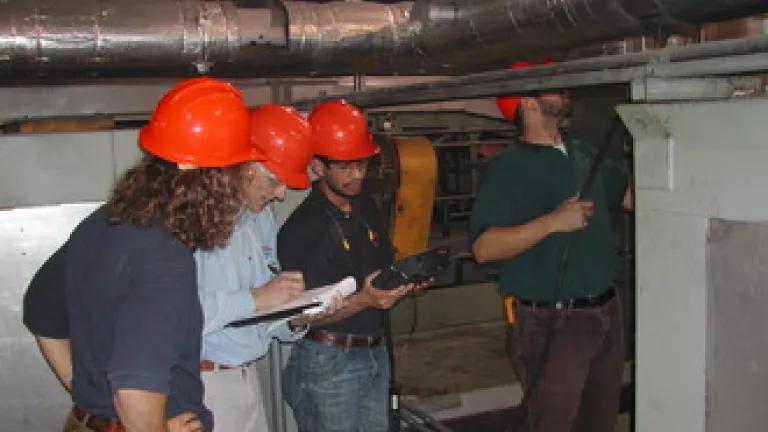
For manufacturing businesses, in today’s economy, every dollar counts. Saving $100,000 a year can make the difference between staying in business in Ohio and chucking in the towel.
And $100,000 is approximately how much money small-to-midsized Ohio manufacturers save, on energy, after free, one-day energy assessments by University of Dayton engineering Professor Kelly Kissock and his teams of graduate students.
Prof. Kelly Kissock (second from the left) and teams of graduate students conduct free, one-day energy assessments that save small-to-midsized Ohio manufacturers an average of $100,000 a year on energy.
These audits, paid for by the US Department of Energy’s Industrial Technologies Program and offered through the U of D’s Industrial Assessment Center, are a boon for Ohio. So are the utility energy-efficiency incentives that can help turn Prof. Kissock’s recommendations into reality. For manufacturers, as I said, they can make the difference between staying in business and not. (Note: Small-to-midsized manufacturers employ almost three-quarters of a million Ohioans.) For state residents, the audits and their implementation mean fewer of the toxic power-plant emissions that endanger their health and that of our already fragile atmosphere. Not bad for a free energy assessment conducted over the course of a single workday. “In small-to-midsized manufacturing,” Prof. Kissock explains, “it’s easy to find cost-effective solutions that can save about 12 percent on energy.”
Since 1981, when the program started, the Industrial Assessment Center has worked with almost 850 of the state’s 3-4,000 small-and-medium sized manufacturers. “In Ohio you’ve got foundries, plastic-injection molding, food manufacturing, furniture,” Prof. Kissock explains. “It’s hard to name a kind of manufacturing we haven’t worked with.”
The US industrial sector accounts for about a third of the nation’s energy use and a third of its air pollution. It’s easy to see why: Their work is energy-intensive. Foundries heat metal, then cool it. Foods are often cooked, then flash-frozen. The plants Kissock and his grad students analyze have whopping energy bills: between $100,000 and $2.5 million a year. “Every plant produces something different,” he explains. “But they all have systems in common,” he says, then rattles off a list that’s a lot for the uninitiated to take in: “electrical systems; lighting; motor drives; fluid flow; compressed air; process heating; process cooling; boilers & hot water systems; HVAC; and, combined heat and power.”
While energy use varies by industry, “if you look across the manufacturing sector as a whole,” Kissock says, “manufacturers spend about 2 percent of sales dollars”—revenue—“on energy.” That might not sound like a lot. But for many, the profit margin is 5 percent, in good economic times. “If companies can cut their energy costs in half, they’ve increased their profit by 20 percent. And in Ohio, there’s a lot of companies that aren’t making 5 percent. They’re making 0 percent,” Kissock says. “Or they’re making 1 percent. So these energy costs become very real to people.”
For the 36 or so manufacturers Kissock’s program has helped in the last two years, energy savings have averaged more than half a million kilowatt hours a year of electricity, the equivalent of taking 76 cars off the road. Natural gas savings knock off another 40 cars-worth. These factory retrofits won’t, singlehandedly, solve the air pollution crisis in Ohio. The state, unfortunately, leads the nation in toxic air pollution from power plants. As a result, each year, more than 1200 Ohioans die prematurely from power-plant pollution; almost 2,000 more suffer non-fatal heart attacks. Still, each energy-efficiency upgrade that Kissock’s group enables makes a difference.
And so do the utility company energy-efficiency incentives that allow the manufacturers Kissock works with to put his program’s recommendations into practice. These incentives have been made possible by Ohio’s Senate Bill 221, the state’s energy efficiency and renewable energy standard.
“I would say that 20 percent of our savings opportunities people get rebates for,” Kissock observes. These financial incentives offered by the state’s investor-owned utilities often enable manufacturers to implement other IAC recommendations they wouldn’t otherwise have been able to afford. “When we come back after nine months, the manufacturers have put in place recommendations that result in about half of the projected savings,” Kissock explains. “After that, they do more.”
All thanks to three important actors: The Department of Energy’s Industrial Technologies Program; utilities’ energy-efficiency incentives; and, of course, Professor Kissock and his teams of talented engineering graduate students.
Not bad for a day’s work.
